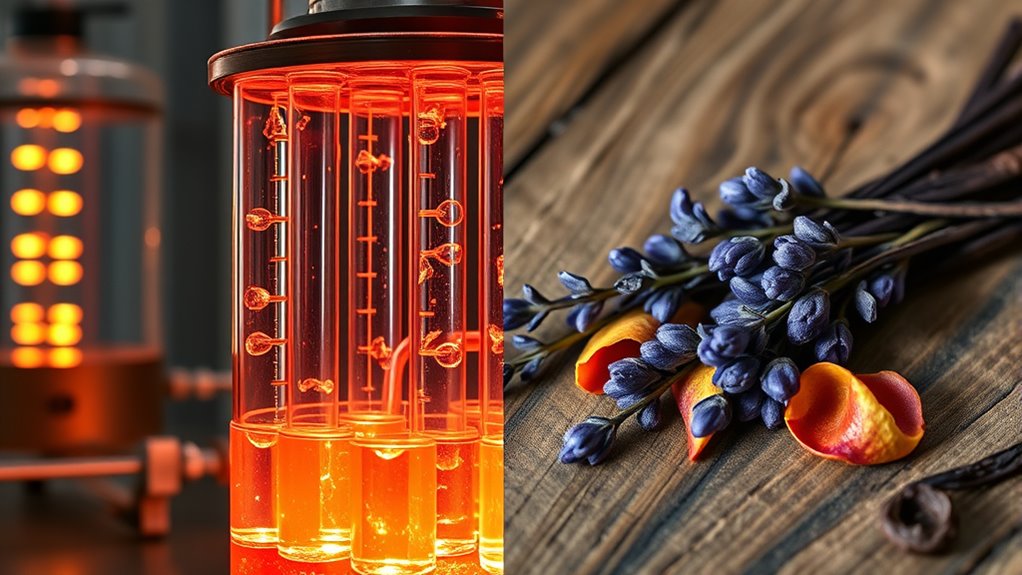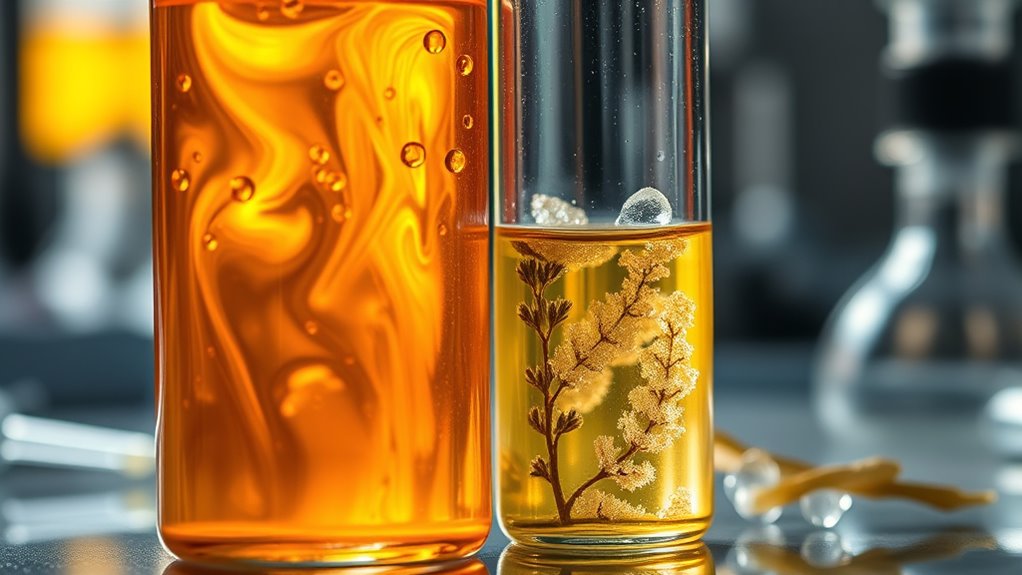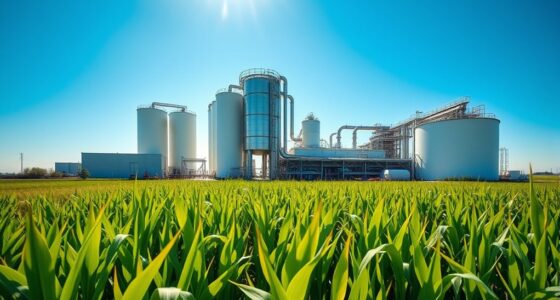You’ll find that biotech fermentation offers a scalable, cost-effective, and eco-friendly way to produce flavors and fragrances, making it an attractive alternative to traditional natural extracts. Natural sources are valued for their authenticity and perceived safety, but they often face challenges like variability and higher costs. As industry trends shift, companies are balancing these approaches to meet consumer demand for transparency and sustainability. To discover how these innovations are shaping the future of scents and tastes, explore further.
Key Takeaways
- Biotech fermentation enables scalable, consistent production of natural-like flavors, reducing reliance on seasonal and geographic sourcing.
- Natural extracts are perceived as more authentic and safe, but face challenges like variability and higher costs.
- Synthetic alternatives offer affordability, consistency, and the ability to mimic complex flavors and scents reliably.
- Industry innovation blurs lines between natural and synthetic, with biotech advancing natural-like products at scale.
- Consumer demand for transparency, safety, and sustainability drives shifts toward biotech and natural extraction methods.

In recent years, the flavor and fragrance industries have experienced significant shifts driven by changing consumer preferences and emerging health trends. You’ve probably noticed that more people are seeking products that align with a natural lifestyle, which influences how flavors and scents are developed and marketed. This shift has led to increased interest in natural extracts, but it has also sparked a debate around the role of synthetic alternatives. While natural extracts are often perceived as safer and more authentic, synthetic alternatives offer consistency, affordability, and a sustainable option for large-scale production. As a consumer, you might find yourself questioning whether a product’s flavor or scent is derived naturally or created synthetically, and your preferences are helping shape industry trends.
Many companies are now leveraging synthetic alternatives to meet consumer demands for variety and cost-effectiveness. These alternatives can replicate complex flavors and fragrances that would otherwise be expensive or difficult to produce from natural sources. For instance, certain fruity or floral notes, which require extensive harvesting of raw materials, can now be synthesized in labs, reducing environmental impact and supply chain issues. Your preference for consistent quality and availability pushes brands to invest in biotechnology and chemical synthesis techniques, making synthetic options more appealing. These synthetic compounds often bypass seasonal limitations and geographic restrictions, giving you a reliable product every time.
However, the rise of natural extracts remains influential. Consumers like you increasingly seek transparency about ingredients, favoring products with natural, recognizable components. This trend encourages brands to source natural extracts responsibly, emphasizing organic farming and sustainable harvesting. Yet, natural extracts come with their own challenges—variability in flavor profiles, higher costs, and limited shelf life. While you might prefer natural options for their perceived purity, you also value products that deliver consistent sensory experiences, which can be tricky with natural sources. This creates a delicate balancing act for manufacturers: they must decide whether to prioritize the authenticity of natural extracts or the consistency and scalability of synthetic alternatives. Additionally, advancements in biotech fermentation are enabling the production of natural-like flavors at scale, further blurring the lines between natural and synthetic sources.
Ultimately, your evolving preferences are at the heart of these shifts. Whether you lean toward natural or synthetic, your desire for safe, effective, and environmentally conscious products pushes the industry to innovate continuously. The ongoing debate between biotech fermentation and natural extraction reflects your search for the best of both worlds—authenticity, safety, affordability, and sustainability. As you make choices, you influence industry practices and encourage brands to refine their methods, shaping the future landscape of flavors and fragrances.
Frequently Asked Questions
How Do Consumer Preferences Influence Flavor and Fragrance Trends?
Consumer demand heavily influences flavor and fragrance trends. You’ll notice a shift toward natural extracts and ethically sourced ingredients, as people prioritize transparency and sustainability. This preference drives brands to innovate with biotech fermentation to meet ethical standards while satisfying taste and scent expectations. As a result, you see a growing market for products that align with your values, blending tradition with modern, sustainable practices to create appealing, responsible flavors and fragrances.
What Are the Environmental Impacts of Biotech Fermentation Versus Natural Extraction?
Like Icarus reaching for the sun, biotech fermentation aims to reduce resource consumption, often with more sustainable practices, but it still requires energy and inputs. Natural extraction, on the other hand, can lead to overharvesting and habitat loss, impacting ecosystems. Overall, biotech offers a potentially greener alternative by minimizing environmental harm, yet it’s essential to weigh resource use carefully to truly benefit the planet.
How Does Regulation Differ Between Biotech and Natural Flavor Sources?
You’ll find that regulation differs markedly between biotech and natural flavor sources. For biotech ingredients, you must navigate strict regulatory compliance and undergo thorough approval processes, often involving safety assessments and genetic modification evaluations. Natural extracts face fewer hurdles, with regulations mainly focusing on purity and labeling. Your approach depends on the source, but biotech products generally require more extensive approval procedures to ensure safety and compliance.
Are There Cost Differences Between Producing Flavors via Biotech and Natural Methods?
They say “you get what you pay for,” but in flavor production, biotech methods often have higher initial production costs due to advanced technology and scalability challenges. Natural extracts might be cheaper upfront, but they face supply limitations and variability. Biotech fermentation can be more scalable long-term, reducing costs over time, but the upfront investment remains significant. So, your choice depends on balancing short-term costs with long-term scalability.
What Are the Future Technological Advancements Expected in Flavor and Fragrance Development?
You’ll see future advancements in flavor and fragrance development through synthetic biology and precision fermentation. These technologies will enable you to create more complex, sustainable, and consistent products by manipulating microorganisms at a genetic level. Expect faster development cycles, reduced costs, and innovative compounds that were previously impossible to produce naturally. As these tools evolve, your ability to craft unique, high-quality flavors and fragrances will become more efficient and environmentally friendly.
Conclusion
As you navigate the evolving world of flavors and fragrances, remember that biotech fermentation and natural extracts each bring unique magic to your creations. Embracing these shifts can open a symphony of sensory experiences, transforming your products into unforgettable masterpieces. The future’s aroma is bursting with innovation, ready to sweep you off your feet like a tidal wave of scent and taste. Stay curious, adapt boldly, and let your creativity soar beyond the horizon of imagination.









